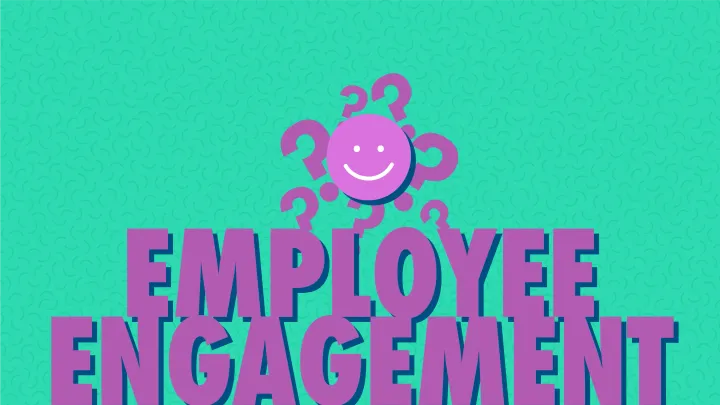Employee engagement surveys: questions, structure, frequency and more

Measuring employee engagement at a small business and running employee engagement surveys can seem pointless – why would you bother spending time understanding what a small number of people think?
But that's where you may be getting it wrong.
At Charlie, we've been running employee engagement surveys for years and for good reasons – we've kept track of our engagement scores, and the more insights we got on our employees, the easier it's been to make the right decisions and improve our retention rate as well as attracting new hires.
In my role, this is something I do on a regular basis, so whether your employee engagement surveys are about policy changes, remote working or wellbeing, I'll help you understand how they can be key to your HR strategy – read on!
What is an employee engagement survey?
An employee engagement survey (also called ‘employee satisfaction survey’) is a questionnaire that companies use to ask their employees how they feel about their work and the company.
Employee engagement surveys are a way to measure how engaged your team is through a set of questions and ratings. Having these employee engagement metrics can then help you make a decision on a particular aspect such as remote working, or even create or iterate HR policies by identifying your team's needs through concrete data.
Why are employee engagement surveys important?
Employee engagement surveys are not a pointless exercise, and they a great tool to collect a lot of insights about your business and iterate your HR policies in the following ways:
- understand how effective and "on point" your HR policies are and whether you need to make any adjustments
- gather honest feedback from your employees by running anonymous surveys
- get granular feedback from each area and department of your business
- have an overall picture of your business by comparing results through different period of times
- make your team members feel involved in the big decisions your business is taking
Another aspect of this is that highly engaged employees tend to display the following traits:
- Greater motivation
- Higher productivity
- A deeper commitment to the work they do
People with high levels of employee engagement also tend to be happier in general and report better levels of personal wellbeing. This often becomes something of a virtuous cycle – the happier you are with your work situation, the more you can invest in your work, the more engaged you become and the less likely you will want to leave.
To put it simply, highly engaged employees generally work harder, deliver better work and stay at their companies for longer. With that in mind, it’s easy to see why employee engagement is such a key concept for small businesses wanting to improve employee retention, especially in the current world of work where many companies face the added challenge of having to engage remote employees.
What types of metrics can you measure in an employee engagement survey?
An employee engagement survey can look at a lot of aspects of your business, but here are the most common types of questions and topics:
- Work-life balance
- Team communication and company-wide communication
- Motivation in their role and tools given to them
- Benefits and salaries
- Career development
- Training opportunities
- Relationship with managers
- Team collaboration
- Leadership
- DE&I
- Changes within your business
5 steps to conduct employee engagement surveys at your business
1- Define what you’re measuring
The first step in this process is defining exactly what it is that you want to measure. As we saw earlier, employee engagement is a very wide-ranging topic and it’s unlikely you could properly dig into every aspect with enough depth for those answers to be useful.
So before you do anything else, think about exactly why you are conducting an employee survey in the first place.
If you’re running a small business, it’s likely that you have a few ideas about what your company does well and what it could improve on. If anything immediately springs to mind, it’s probably worth digging deeper into those issues.
Perhaps your company is lacking in development opportunities? Maybe your team members feel frustrated by opaque decision-making by the leadership team? Unless you ask, you'll never know.
CharlieHR’s engagement survey tool can help you solve this problem – our in-built templates have been designed by industry experts and tailored specifically to get insights on specific areas of your business.
Each template includes a list of questions, designed to give you the best overview of how you’re doing as a business.
They cover the most common types engagement surveys, including:
- Employee wellbeing survey
- Employee motivation survey
- Teamwork efficiency survey
- Leadership survey
- Growth and development survey
- Remote working survey questions
All you need to do is pick one of the templates, and the system will automatically send the questionnaire to your employees and collect responses.

2. Come up with the right employee engagement survey questions
Once you know what area you’re going to focus on with your questionnaire, it’s time to pick your types of survey questions. Think about the balance between the types of engagement survey questions you would like:
- Closed-ended questions are useful when the information you want is binary in nature – yes or no, better or worse, more or less.
- Open-ended questions are much more useful when trying to draw out information that is more complex, or if you’re trying to find inspiration for future changes to the way you work.
- Use rating-scale questions, maybe using the Likert scale like we do at Charlie: this format allows you to measure to what extent team members agree with a statement in your survey.
If you’d like to have a look at some examples, check out our article on employee engagement surveys questions or explore our employee engagement survey template.
We also recommend to:
- keep your survey snappy – the longer the survey takes to fill out, the less likely your team are to complete it.
- be wary of your own bias. Your objective here is to elicit honest feedback from your team – be careful that the way you phrase your questions doesn’t affect the answers you receive.
Not sure what that means? Have a look at our built-in templates — our questions have been specifically designed to avoid bias of any kind. Sign up for a free 7-day trial today.
3. Make your engagement surveys anonymous
A lot of free engagement survey tools out there don’t guarantee complete anonymity, and in the context of HR, this could be problematic.
If you want to get genuine feedback from your team members, you'll need to guarantee anonymity and that's something a system like CharlieHR allows you to do.
With Charlie, the system takes care of distributing your questionnaires to your team members and of collecting their responses. All the data is anonymised — so you can analyse it while also protecting your employees’ rights.
CharlieHR is designed specifically to run surveys in the context of HR, which guarantees complete compliance with UK employment law, for your peace of mind.
4. Choose the right time to launch your employee engagement survey
Traditionally speaking, many businesses have opted for annual surveys – but over recent years the trend has been to use employee surveys much more regularly. Annual surveys are now seen as far too irregular to be useful or effectively drive business success.
Instead, many companies and survey providers lean towards 'pulse surveys' – much more regular surveys that help keep your finger on the pulse of what's happening inside your business.
With Charlie, for example, you have can choose the cadence at which you want to send out your engagement surveys – whether it's one question per week or all the questions at once, it doesn't matter. You can also schedule surveys to run automatically at regular intervals, for example once every quarter. You're in charge!
5. Choose the right employee engagement survey provider
It’s not always advisable to design your own employee engagement survey from scratch. Unless you have a very specific topic that you want to dig into, it’s often much easier and much more insightful to use a survey built by the experts. This is where specialist employee engagement software comes in.
When it comes to choosing the right one, it’s a case of finding the best fit for you and your company. There is no ‘best one’ – just a variety of pulse survey tools that suit different companies at different stages of their journey.
SurveyMonkey
SurveyMonkey provides a highly-specialised survey tool best-suited to large companies with a dedicated People or HR team who has experience working tracking engagement metrics. It’s undoubtedly a powerful platform and it also gives you access to advanced features like A/B testing and branching logic, but it can take some getting used to – it’s probably helpful to think of it as a ‘second’ engagement software, once you’ve mastered the basics.
You can have a look at our guide on SurveyMonkey alternatives
Google Forms
Google Forms is free if you already have a Google account, and it can work if all you’re interested in is collecting basic information using online forms. However, it is not a tool designed for HR teams: there’s no question bank to pre-populate or seek inspiration from, and it doesn’t help you analyse the results in any way. Check out our guide on Google Forms alternatives or compare it to SurveyMonkey VS Google Forms.
CharlieHR
Charlie’s own employee engagement feature, Polls, was designed as the perfect ‘first-step’ into the world of employee engagement for small businesses. Polls allows you to choose from a bank of ready-made surveys digging into different aspects of employee engagement – so you’re confident you’re asking the right questions. You can track survey completion and analyse results for a user-friendly dashboard.
6. Make your engagement surveys personal with focus groups or one-to-ones
Using specialised engagement tools or designing your own employee surveys are great methods for learning more about your team – but they aren't the only options.
Sometimes, a more casual and collaborative approach is more effective. This is where focus groups come into play. Focus groups are a form of group conversation where you can discuss issues with team members in a more informal setting. They can be a good way of digging into the employee experience without predefining the responses with inherently 'closed' survey questions.
They can also be an effective way of overcoming one of the most common challenges to many survey processes: poor participation rates or response rates. With a focus group, it's much easier to get good employee feedback – all you need to do is get them in the room.
7. Act on the employee engagement survey results
Running an effective survey is only half the battle. To actually make a difference to the engagement of your team, you have to follow through on the employee engagement survey results and take action with a targeted employee engagement strategy.
Hopefully, the results of the engagement survey will have surfaced some clear opportunities – perhaps your survey data has identified some specific obstacles that are preventing your team from connecting fully with their work. If that’s the case, you can get to work creating an action plan so you can address them.
In many cases, the next step is to take your findings to the company's senior leadership or management team. Pretty often, you're going to need their help implementing that action plan, particularly if it requires significant changes to your policies.
There’s always the chance, however, that you need to clarify your employees’ feedback a little. Charlie’s HR platform helps you analyse employee engagement survey results, ensuring the data you collected is statistically significant — if that’s not the case, it will flag that you’ll need to collect more responses before you jump to hasty conclusions.

FAQ for employee engagement surveys
What’s the difference between employee engagement and employee enablement?
Employee engagement refers to the emotional connection, commitment and enthusiasm that team members have towards their work and your company.
On the other hand, employee enablement focuses on giving employees the resources, tools and autonomy to do their job well, empowering them to make decisions and take ownership of their work.
You can look at engagement as the emotional end goal, and at enablement as the practical support and empowerment necessary for team members to experience it.
Do you have tips on how to run an employee engagement survey?
On top of the steps we've outlined in this article, there's a little more to it that you can think about:
- Choose the right timing – don't pick a time where everyone is super busy – of course that's likely to be all the time for a startup, but think about when it makes sense to do an engagement survey
- Communicate and over communicate – getting people to complete a survey can be difficult, so it's important you communicate as much as you can on how important it is and how you would like the survey to be completed. Maybe even put incentives in place if it's a really important engagement survey.




